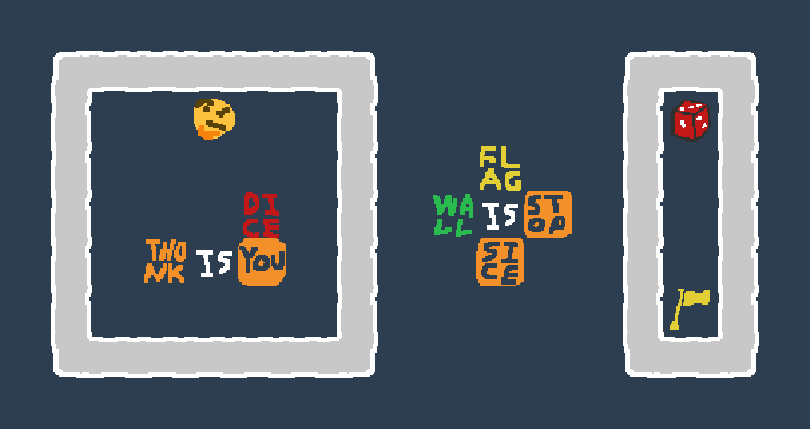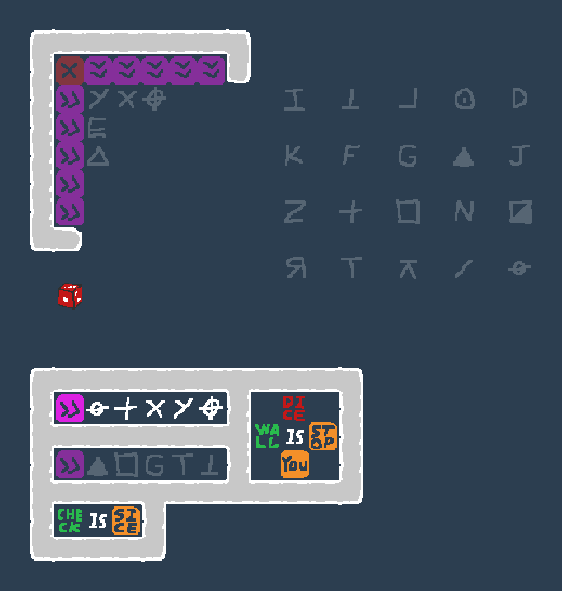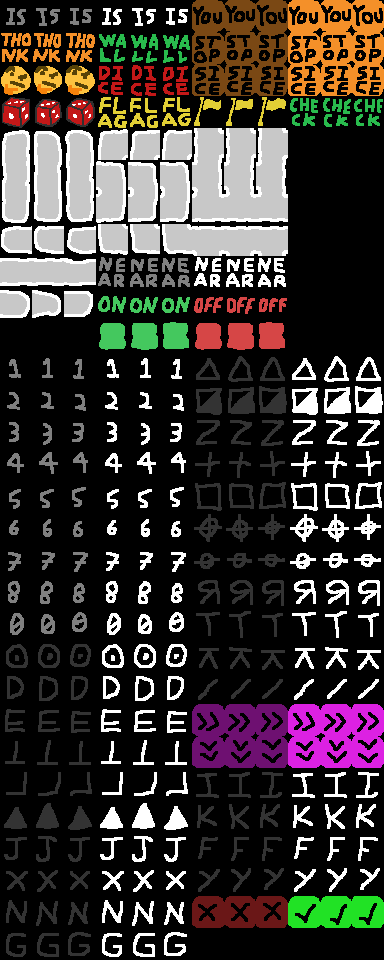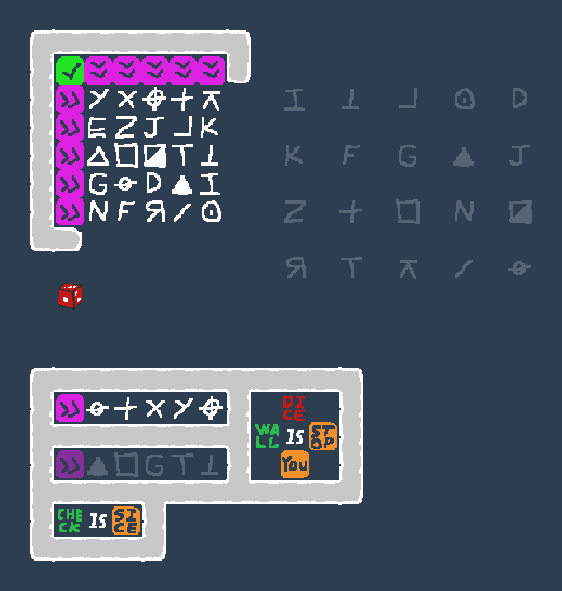dice-is-you
Categories: re
2021-02-08
by not_really
dice-is-you

First blood… that was fast
A baba is you clone but with dice I guess.
It’s an SDL game written in C and compiled in wasm.
I talked with a few people in discord who said wasm2c works with ghidra, but I usually just use wasm2wat and wasm-decompile to modify and read code.
The game
The game works just like Baba is You, you use the IS blocks to make certain things do certain other things. So in the screenshot above, pushing THONK out of the way and replacing it with DICE let’s “YOU” become the dice on the right and get the flag. Sadly the last level is a bit different and doesn’t really use these mechanics.

It took me a bit to realize, but the examples at the bottom with the two purple arrows show a passing condition and a failing condition. If you put some correct combination of characters together, you can make the arrow and characters light up. We probably need to get all the arrows on the top to light up to make the X turn into a check.
If we browse around a bit, we can find these functions in the wasm (with a few comments):
function check_code(a:int, b:int, c:int, d:int):int //main checking code
function get_code_value(a:int):int //gets code represented by block
function code(a:int, b:int, c:int, d:int, e:int):int //checks with code values
Let’s look at check_code first.
function check_code(a:int, b:int, c:int, d:int):int {
var e:int = g_a;
var f:int = 32;
var g:int = e - f;
var dc:int = g;
if (dc < g_c) { handle_stack_overflow() }
g_a = dc;
label B_a:
g[6]:int = a;
g[5]:int = b;
g[4]:int = c;
g[3]:int = d;
var h:{ a:int } = g[4]:int;
var i:int = h.a;
var j:int = get_code_value(i);
g[11]:byte = j;
var k:int = g[4]:int;
var l:int = k[1]:int;
var m:int = get_code_value(l);
g[10]:byte = m;
var n:int = g[4]:int;
var o:int = n[2]:int;
var p:int = get_code_value(o);
g[9]:byte = p;
var q:int = g[4]:int;
var r:int = q[3]:int;
var s:int = get_code_value(r);
g[8]:byte = s;
var t:int = g[4]:int;
var u:int = t[4]:int;
var v:int = get_code_value(u);
g[7]:byte = v;
var w:int = g[11]:ubyte;
var x:int = 255;
var y:int = w & x;
if (eqz(y)) goto B_e;
var z:int = g[10]:ubyte;
var aa:int = 255;
var ba:int = z & aa;
if (eqz(ba)) goto B_e;
var ca:int = g[9]:ubyte;
var da:int = 255;
var ea:int = ca & da;
if (eqz(ea)) goto B_e;
var fa:int = g[8]:ubyte;
var ga:int = 255;
var ha:int = fa & ga;
if (eqz(ha)) goto B_e;
var ia:int = g[7]:ubyte;
var ja:int = 255;
var ka:int = ia & ja;
if (ka) goto B_d;
label B_e:
var la:int = 0;
var ma:int = 1;
var na:int = la & ma;
g[31]:byte = na;
goto B_c;
label B_d:
var oa:int = g[11]:ubyte;
var pa:int = g[10]:ubyte;
var qa:int = g[9]:ubyte;
var ra:int = g[8]:ubyte;
var sa:int = g[7]:ubyte;
var ta:int = 255;
var ua:int = oa & ta;
var va:int = 255;
var wa:int = pa & va;
var xa:int = 255;
var ya:int = qa & xa;
var za:int = 255;
var ab:int = ra & za;
var bb:int = 255;
var cb:int = sa & bb;
var db:int = code(ua, wa, ya, ab, cb);
g[6]:byte = db;
var eb:int = g[6]:ubyte;
var fb:int = 255;
var gb:int = eb & fb;
if (gb) goto B_f;
//pass
var hb:int = 1;
var ib:int = 1;
var jb:{ a:int } = g[4]:int;
var kb:int = jb.a;
kb[45]:byte = ib;
var lb:int = g[4]:int;
var mb:int = lb[1]:int;
mb[45]:byte = ib;
var nb:int = g[4]:int;
var ob:int = nb[2]:int;
ob[45]:byte = ib;
var pb:int = g[4]:int;
var qb:int = pb[3]:int;
qb[45]:byte = ib;
var rb:int = g[4]:int;
var sb:int = rb[4]:int;
sb[45]:byte = ib;
var tb:int = 1;
var ub:int = hb & tb;
g[31]:byte = ub;
goto B_c;
label B_f: //fail
var vb:int = 0;
var wb:int = 1;
var xb:int = vb & wb;
g[31]:byte = xb;
//////////////////////////
label B_c:
var yb:int = g[31]:ubyte;
var zb:int = 1;
var ac:int = yb & zb;
var bc:int = 32;
var cc:int = g + bc;
var ec:int = cc;
if (ec < g_c) { handle_stack_overflow() }
g_a = ec;
label B_g:
return ac;
}
When reading decompiled wasm output, it’s best not to get overwhelmed. Try to see what functions are being called, and then take a guess about what’s going on, then see if it checks out.
For me, it’s easiest to start with the win condition then work backwards from there. The return value is ac which comes from yb which comes from g[31] which comes from two places.
- On the bottom, where I wrote
fail,g[31]is set tovbwhich is 0. So that’s going to return false. - On the other hand, above that,
g[31]is set toubwhich is set tohbwhich is 1. So that passes.
The condition to go down the pass branch is that gb == 0 which comes from g[6] which comes from db which comes from calling code(). The values from code are g[7]-g[11], and at the very top you can see those come from get_code_value five times. So the code we care about probably is something like this:
function check_code(a, b, c, d, e) {
var codeA = get_code_value(a);
var codeB = get_code_value(b);
var codeC = get_code_value(c);
var codeD = get_code_value(d);
var codeE = get_code_value(e);
var finalCode = code(codeA, codeB, codeC, codeD, codeE);
return finalCode == 0;
}
Where a, b, c, d, and e somehow represent the block types.
Let’s see what’s in get_code_value.
function get_code_value(a:int):int {
var b:int = g_a;
var c:int = 16;
var d:int = b - c;
d[2]:int = a;
var e:int = d[2]:int;
var f:int = e[1]:int;
var g:int = -138;
var h:int = f + g;
var i:int = 210;
h > i;
br_table[B_f, B_b, B_b, B_b, B_b, B_b, B_b, B_b, B_b, B_b, B_b, B_b,
B_r, B_b, B_b, B_b, B_b, B_b, B_b, B_b, B_b, B_b, B_b, B_b,
B_c, B_b, B_b, B_b, B_b, B_b, B_b, B_b, B_b, B_b, B_b, B_b,
B_l, B_b, B_b, B_b, B_b, B_b, B_b, B_b, B_b, B_b, B_b, B_b,
B_i, B_b, B_b, B_b, B_b, B_b, B_b, B_b, B_b, B_b, B_b, B_b,
B_g, B_b, B_b, B_b, B_b, B_b, B_b, B_b, B_b, B_b, B_b, B_b,
B_j, B_b, B_b, B_b, B_b, B_b, B_b, B_b, B_b, B_b, B_b, B_b,
B_z, B_b, B_b, B_b, B_b, B_b, B_b, B_b, B_b, B_b, B_b, B_b,
B_h, B_b, B_b, B_b, B_b, B_b, B_y, B_b, B_b, B_b, B_b, B_b,
B_m, B_b, B_b, B_b, B_b, B_b, B_x, B_b, B_b, B_b, B_b, B_b,
B_k, B_b, B_b, B_b, B_b, B_b, B_w, B_b, B_b, B_b, B_b, B_b,
B_b, B_b, B_b, B_b, B_b, B_b, B_u, B_b, B_b, B_b, B_b, B_b,
B_b, B_b, B_b, B_b, B_b, B_b, B_aa, B_b, B_b, B_b, B_b, B_b,
B_q, B_b, B_b, B_b, B_b, B_b, B_t, B_b, B_b, B_b, B_b, B_b,
B_o, B_b, B_b, B_b, B_b, B_b, B_p, B_b, B_b, B_b, B_b, B_b,
B_v, B_b, B_b, B_b, B_b, B_b, B_e, B_b, B_b, B_b, B_b, B_b,
B_d, B_b, B_b, B_b, B_b, B_b, B_n, B_b, B_b, B_b, B_b, B_b,
B_b, B_b, B_b, B_b, B_b, B_b, B_s, ..B_b](
h)
label B_aa:
var j:int = 1;
d[15]:byte = j;
goto B_a;
label B_z:
var k:int = 5;
d[15]:byte = k;
goto B_a;
label B_y:
var l:int = 18;
d[15]:byte = l;
goto B_a;
label B_x:
var m:int = 25;
d[15]:byte = m;
goto B_a;
label B_w:
var n:int = 48;
d[15]:byte = n;
goto B_a;
label B_v:
var o:int = 49;
d[15]:byte = o;
goto B_a;
label B_u:
var p:int = 55;
d[15]:byte = p;
goto B_a;
label B_t:
var q:int = 61;
d[15]:byte = q;
goto B_a;
label B_s:
var r:int = 96;
d[15]:byte = r;
goto B_a;
label B_r:
var s:int = 119;
d[15]:byte = s;
goto B_a;
label B_q:
var t:int = 120;
d[15]:byte = t;
goto B_a;
label B_p:
var u:int = 135;
d[15]:byte = u;
goto B_a;
label B_o:
var v:int = 138;
d[15]:byte = v;
goto B_a;
label B_n:
var w:int = 148;
d[15]:byte = w;
goto B_a;
label B_m:
var x:int = 150;
d[15]:byte = x;
goto B_a;
label B_l:
var y:int = 160;
d[15]:byte = y;
goto B_a;
label B_k:
var z:int = 163;
d[15]:byte = z;
goto B_a;
label B_j:
var aa:int = 171;
d[15]:byte = aa;
goto B_a;
label B_i:
var ba:int = 179;
d[15]:byte = ba;
goto B_a;
label B_h:
var ca:int = 183;
d[15]:byte = ca;
goto B_a;
label B_g:
var da:int = 189;
d[15]:byte = da;
goto B_a;
label B_f:
var ea:int = 192;
d[15]:byte = ea;
goto B_a;
label B_e:
var fa:int = 194;
d[15]:byte = fa;
goto B_a;
label B_d:
var ga:int = 212;
d[15]:byte = ga;
goto B_a;
label B_c:
var ha:int = 247;
d[15]:byte = ha;
goto B_a;
label B_b:
var ia:int = 0;
d[15]:byte = ia;
label B_a:
var ja:int = d[15]:ubyte;
var ka:int = 255;
var la:int = ja & ka;
return la;
}
This one seems pretty messy, but it looks like some sort of jump table. I realized there’s a pattern in the table that helped me realize this represents the sprite ids.
B_f, B_b, B_b, B_b, B_b, B_b,
B_b, B_b, B_b, B_b, B_b, B_b, B_r, B_b, B_b, B_b, B_b, B_b,
B_b, B_b, B_b, B_b, B_b, B_b, B_c, B_b, B_b, B_b, B_b, B_b,
B_b, B_b, B_b, B_b, B_b, B_b, B_l, B_b, B_b, B_b, B_b, B_b,
B_b, B_b, B_b, B_b, B_b, B_b, B_i, B_b, B_b, B_b, B_b, B_b,
B_b, B_b, B_b, B_b, B_b, B_b, B_g, B_b, B_b, B_b, B_b, B_b,
B_b, B_b, B_b, B_b, B_b, B_b, B_j, B_b, B_b, B_b, B_b, B_b,
B_b, B_b, B_b, B_b, B_b, B_b, B_z, B_b, B_b, B_b, B_b, B_b,
B_b, B_b, B_b, B_b, B_b, B_b, B_h, B_b, B_b, B_b, B_b, B_b,
B_y, B_b, B_b, B_b, B_b, B_b, B_m, B_b, B_b, B_b, B_b, B_b,
B_x, B_b, B_b, B_b, B_b, B_b, B_k, B_b, B_b, B_b, B_b, B_b,
B_w, B_b, B_b, B_b, B_b, B_b, B_b, B_b, B_b, B_b, B_b, B_b,
B_u, B_b, B_b, B_b, B_b, B_b, B_b, B_b, B_b, B_b, B_b, B_b,
B_aa,B_b, B_b, B_b, B_b, B_b, B_q, B_b, B_b, B_b, B_b, B_b,
B_t, B_b, B_b, B_b, B_b, B_b, B_o, B_b, B_b, B_b, B_b, B_b,
B_p, B_b, B_b, B_b, B_b, B_b, B_v, B_b, B_b, B_b, B_b, B_b,
B_e, B_b, B_b, B_b, B_b, B_b, B_d, B_b, B_b, B_b, B_b, B_b,
B_n, B_b, B_b, B_b, B_b, B_b, B_b, B_b, B_b, B_b, B_b, B_b,
B_s, B_b, ...
If you look at the spritesheet:

You can see how the table lines up with the sprite sheet starting with the white hollow triangle. It skips the purple arrows and x/check marks (B_b). So it looks like each sprite gets a value represented with it by jumping to a certain place in the code and setting the value to return. Problem is, we don’t want to have to do all of this manually, right?
Enter closure compiler. It’s not the best method, but it works here. What we can do is convert all of the jumps into variables, move it to above the array, and closure compiler can simplify it.
Here’s how to do that.
- Find and replace
:\r\n var .*:intwith nothing - Find and replace
\r\n d\[15\]:byte = .*;\r\n goto B_a;\r\n labelwith\r\nvar - Move the variables to the top and make
br_tableto a variable
If you did it right, you get
var B_aa = 1;
var B_z = 5;
var B_y = 18;
var B_x = 25;
var B_w = 48;
var B_v = 49;
var B_u = 55;
var B_t = 61;
var B_s = 96;
var B_r = 119;
var B_q = 120;
var B_p = 135;
var B_o = 138;
var B_n = 148;
var B_m = 150;
var B_l = 160;
var B_k = 163;
var B_j = 171;
var B_i = 179;
var B_h = 183;
var B_g = 189;
var B_f = 192;
var B_e = 194;
var B_d = 212;
var B_c = 247;
var B_b = 0;
var br_table = [B_f, B_b, B_b, B_b, B_b, B_b, B_b, B_b, B_b, B_b, B_b, B_b,
B_r, B_b, B_b, B_b, B_b, B_b, B_b, B_b, B_b, B_b, B_b, B_b, B_c, B_b, B_b,
B_b, B_b, B_b, B_b, B_b, B_b, B_b, B_b, B_b, B_l, B_b, B_b, B_b, B_b, B_b,
B_b, B_b, B_b, B_b, B_b, B_b, B_i, B_b, B_b, B_b, B_b, B_b, B_b, B_b, B_b,
B_b, B_b, B_b, B_g, B_b, B_b, B_b, B_b, B_b, B_b, B_b, B_b, B_b, B_b, B_b,
B_j, B_b, B_b, B_b, B_b, B_b, B_b, B_b, B_b, B_b, B_b, B_b, B_z, B_b, B_b,
B_b, B_b, B_b, B_b, B_b, B_b, B_b, B_b, B_b, B_h, B_b, B_b, B_b, B_b, B_b,
B_y, B_b, B_b, B_b, B_b, B_b, B_m, B_b, B_b, B_b, B_b, B_b, B_x, B_b, B_b,
B_b, B_b, B_b, B_k, B_b, B_b, B_b, B_b, B_b, B_w, B_b, B_b, B_b, B_b, B_b,
B_b, B_b, B_b, B_b, B_b, B_b, B_u, B_b, B_b, B_b, B_b, B_b, B_b, B_b, B_b,
B_b, B_b, B_b, B_aa, B_b, B_b, B_b, B_b, B_b, B_q, B_b, B_b, B_b, B_b, B_b,
B_t, B_b, B_b, B_b, B_b, B_b, B_o, B_b, B_b, B_b, B_b, B_b, B_p, B_b, B_b,
B_b, B_b, B_b, B_v, B_b, B_b, B_b, B_b, B_b, B_e, B_b, B_b, B_b, B_b, B_b,
B_d, B_b, B_b, B_b, B_b, B_b, B_n, B_b, B_b, B_b, B_b, B_b, B_b, B_b, B_b,
B_b, B_b, B_b, B_s, B_b];
alert(br_table); //prevent optos in closure
alert(br_table);
Throw it in closure on advanced pretty print to get an array like this (after me formatting it):
192,000,000,000,000,000,
000,000,000,000,000,000,119,000,000,000,000,000,
000,000,000,000,000,000,247,000,000,000,000,000,
000,000,000,000,000,000,160,000,000,000,000,000,
000,000,000,000,000,000,179,000,000,000,000,000,
000,000,000,000,000,000,189,000,000,000,000,000,
000,000,000,000,000,000,171,000,000,000,000,000,
000,000,000,000,000,000,005,000,000,000,000,000,
000,000,000,000,000,000,183,000,000,000,000,000,
018,000,000,000,000,000,150,000,000,000,000,000,
025,000,000,000,000,000,163,000,000,000,000,000,
048,000,000,000,000,000,000,000,000,000,000,000,
055,000,000,000,000,000,000,000,000,000,000,000,
001,000,000,000,000,000,120,000,000,000,000,000,
061,000,000,000,000,000,138,000,000,000,000,000,
135,000,000,000,000,000,049,000,000,000,000,000,
194,000,000,000,000,000,212,000,000,000,000,000,
148,000,000,000,000,000,000,000,000,000,000,000,
096,000...
So now we know what value each sprite is.
Finally time for code.
function code(a:int, b:int, c:int, d:int, e:int):int {
var f:int = g_a;
var g:int = 16;
var h:int = f - g;
h[15]:byte = a;
h[14]:byte = b;
h[13]:byte = c;
h[12]:byte = d;
h[11]:byte = e;
var i:int = h[15]:ubyte;
var j:int = 255;
var k:int = i & j;
var l:int = 42;
var m:int = k * l;
var n:int = h[14]:ubyte;
var o:int = 255;
var p:int = n & o;
var q:int = 1337;
var r:int = p * q;
var s:int = m + r;
var t:int = h[13]:ubyte;
var u:int = 255;
var v:int = t & u;
var w:int = s + v;
var x:int = h[13]:ubyte;
var y:int = 255;
var z:int = x & y;
var aa:int = h[12]:ubyte;
var ba:int = 255;
var ca:int = aa & ba;
var da:int = z ^ ca;
var ea:int = w + da;
var fa:int = h[11]:ubyte;
var ga:int = 255;
var ha:int = fa & ga;
var ia:int = 1;
var ja:int = ha << ia;
var ka:int = ea + ja;
var la:int = 255;
var ma:int = ka & la;
return ma;
}
code takes our five values from earlier. To help us again, we’ll make it look like javascript and then give it to closure compiler to simplify. All you need to do here is replace :int with nothing and replace h[11]-h[15] with a-e. Once you put that through closure, you’ll get this:
function codef(a, b, c, d, e) {
return 42 * (a & 255) + 1337 * (b & 255) + (c & 255) + ((c & 255) ^ (d & 255)) + ((e & 255) << 1) & 255;
}
That’s a little better. Somehow, with this function, we need to get the values equal to 0.
Why try to figure it out when you can just chuck it into z3.
Here’s the conditions to get the flag in this game:
* 25 values
* All values show up only once
* Five of the values are already confirmed
* Check must pass in all 10 directions
Here’s the code that I used:
from z3 import *
ar = [BitVec(f'{i}', 8) for i in range(25)]
s = Solver()
# our possible options
for i in range(25):
s.add(Or(ar[i] == 192, ar[i] == 119, ar[i] == 247, ar[i] == 160, ar[i] == 179,
ar[i] == 189, ar[i] == 171, ar[i] == 5, ar[i] == 183, ar[i] == 18,
ar[i] == 150, ar[i] == 25, ar[i] == 163, ar[i] == 48, ar[i] == 55,
ar[i] == 1, ar[i] == 120, ar[i] == 61, ar[i] == 138, ar[i] == 135,
ar[i] == 49, ar[i] == 194, ar[i] == 212, ar[i] == 148, ar[i] == 96))
# the five tiles already on the board
s.add(ar[0+0] == 212)
s.add(ar[1+0] == 194)
s.add(ar[2+0] == 189)
s.add(ar[0+1*5] == 48)
s.add(ar[0+2*5] == 192)
# horizontal checks all pass
for i in range(5):
s.add((42 * (ar[0+i*5] & 255) + 1337 * (ar[1+i*5] & 255) + (ar[2+i*5] & 255) + ((ar[2+i*5] & 255) ^ (ar[3+i*5] & 255)) + ((ar[4+i*5] & 255) << 1) & 255) == 0)
# vertical passes all check
for i in range(5):
s.add((42 * (ar[0+i] & 255) + 1337 * (ar[5+i] & 255) + (ar[10+i] & 255) + ((ar[10+i] & 255) ^ (ar[15+i] & 255)) + ((ar[20+i] & 255) << 1) & 255) == 0)
# all values in array are unique
s.add(Distinct(ar))
print(s.check())
model = s.model()
print(model)
results = ([int(str(model[ar[i]])) for i in range(len(model))])
from_value = [192,119,247,160,179,189,171,5,183,18,150,25,163,48,55,1,120,61,138,135,49,194,212,148,96]
to_spriteid = [138,150,162,174,186,198,210,222,234,240,246,252,258,264,276,288,294,300,306,312,318,324,330,336,348]
for i in range(5):
print(f"{to_spriteid[from_value.index(results[0+i*5])]} {to_spriteid[from_value.index(results[1+i*5])]} {to_spriteid[from_value.index(results[2+i*5])]} {to_spriteid[from_value.index(results[3+i*5])]} {to_spriteid[from_value.index(results[4+i*5])]}")
Output:
330 324 198 174 246
264 162 312 288 306
138 186 150 234 276
348 210 252 300 294
336 318 222 258 240
Here’s a table to go from sprite id to sprite description:
/\ 138
[/] 150
Z 162
+ 174
[] 186
+o+ 198
-o- 210
R 222
T 234
C 240
^ 246
D 252
/ 258
E 264
| 276
_| 288
I 294
/\F 300
K 306
J 312
F 318
X 324
Y 330
N 336
G 348

I placed these by editing the wat because I was too lazy to move the blocks during testing, that’s why there’s still blocks on the right.